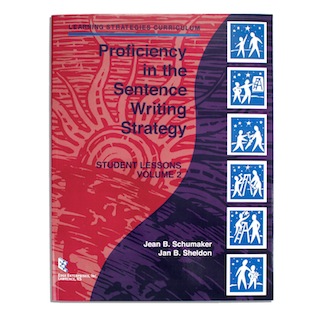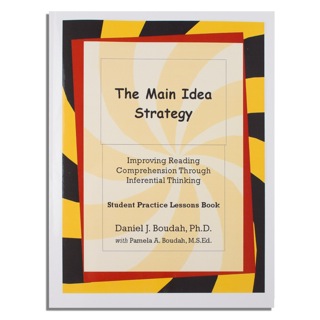Description
Research on Sentence Writing Strategy Instruction
Study 1
Overview
This study focused on the instruction of four writing strategies within a resource room program by the regularly assigned special education teacher. The writing strategies were taught across the course of a full school year. General education English and social studies teachers were recruited to give writing assignments in their classes to provide measures of generalization. Seven participating high school students with LD who had not been enrolled in general education courses in the past were enrolled in these English and social studies classes at the beginning of the school year. The students were first taught the Sentence Writing Strategy (Schumaker & Sheldon, 1985) by their special education teacher in the resource room. Next, the students learned the Paragraph Writing Strategy (Schumaker & Lyerla, 1991). Subsequently, they learned how to detect and correct errors in their writing by learning the Error Monitoring Strategy (Schumaker, Nolan, & Deshler, 1985). Finally, they learned the Theme Writing Strategy (Schumaker, 2003). Throughout the instruction, the students’ writing performance in both the resource room and in the targeted general education classes was monitored. That is, every time they wrote a paragraph or an essay in any of the targeted settings, the product was scored for the types of sentences used, the organization of the paragraph, the number of errors, and the organization of the essay. A multiple-probe across-strategies design was employed.
Results
The seven students wrote an average of 70% complete sentences during baseline and an average of 99% complete sentences after instruction on products written in the resource room and in general education classes. They wrote an average of 18% complicated sentences before instruction and an average of 65% complicated sentences after instruction on products written in the resource room and in general education classes. The multiple-baseline across-strategies design demonstrated that each student made gains on pertinent measures only after instruction began for each strategy.
Five of the students made the same kinds of gains on their writing assignments in general education classes as they did in the resource room, even though they had not been taught to use the writing strategies in those settings. The two students who did not generalize their use of the strategies to other classes did so quickly after they had been taught to do so.
Before the study, the students’ GPA was 2.1 in special English and social studies courses designed for low-achieving students and students with disabilities; after the study, their GPA was 2.7 in regular-track general education English and social studies courses.
On a standardized test of writing instruction, the Woodcock Johnson Psychoeducational Battery, the students’ mean grade equivalent score increased by two grade levels from 6.2 to 8.2. On the district’s minimal competency writing exam, the students earned a mean overall score of 3.5 (out of 5.0), which compared favorably to the mean overall district average of 2.5. With regard to maintenance of strategy usage, the four students who returned to the school the following school year and who had learned all the strategies demonstrated that they could write complete and complicated sentences in their general education classes at mastery levels.
Conclusions
Thus, this study demonstrated that high school students with LD could learn the Sentence Writing Strategy in a resource room program when instructed by their regularly assigned special education teacher. It also showed that they could generalize their use of the Sentence Writing Strategy to assignments given in their required general education courses and that they could maintain their use of the strategy across several months. It also showed that strategy instruction was associated with growth in standardized writing test scores and produced favorable writing competency test scores.
Reference
Schmidt, J. L. (1983). The effects of four generalization conditions on learning disabled adolescents’ written language performance in the regular classroom. Unpublished doctoral dissertation. University of Kansas, Lawrence.
Schmidt, J. L., Deshler, D. D., Schumaker, J. B., & Alley, G. R. (1989). Effects of generalization instruction on the written language performance of adolescents with learning disabilities in the mainstream classroom. Reading, Writing, and Learning Disabilities, 4(4), 291-309.
Study 2
Overview
In this study, two writing strategies were taught in a 10th-grade English class containing 31 students. A comparison class contained 25 students. Three students with disabilities, three high-achieving students, and three low-achieving students within each class served as targeted subjects for the multiple-probe across-strategies design. The students in the experimental class received instruction in the Sentence Writing Strategy and then the Error Monitoring Strategy through the use of the eight-stage strategic instructional methodology combined with cooperative-group structures. Students in the comparison class received traditional writing instruction. Measures included the percentage of complete sentences, the percentage of complicated sentences (compound, complex, and compound-complex sentences), and an error score (the total number of errors divided by the total number of words written subtracted from 100).
Results
The students in the two classes were somewhat comparable at the beginning of the study. For example, the targeted students with LD in the experimental class wrote an average of 45% complete sentences, and those in the comparison class wrote an average of 35% complete sentences. Low-achieving students in the experimental class wrote an average of 35% complete sentences, and those in the comparison class wrote an average of 50% complete sentences. All students in the experimental class wrote an average of 55% complete sentences and in the comparison class wrote an average of 67% complete sentences.
With regard to student generation of complicated sentences before instruction, the targeted students with LD in the experimental class wrote an average of 12% complicated sentences, and those in the comparison class wrote an average of 32% complicated sentences. Low-achieving students in the experimental class wrote an average of 6% complicated sentences, and those in the comparison class wrote an average of 10% complicated sentences. All students in the experimental class wrote an average of 22% complicated sentences and in the comparison class wrote an average of 28% complicated sentences.
All the targeted students in the experimental class mastered the Sentence Writing Strategy after the instruction as shown by the multiple-probe design. After the instruction, the experimental students with LD wrote an average of 90% complete sentences, and the low-achieving students wrote an average of 80% complete sentences. The comparison students with LD and low-achieving students wrote an average of 40% complete sentences after traditional instruction. Also after instruction, all the experimental students wrote an average of 95% complete sentences; all the comparison students wrote an average of 55% complete sentences. Experimental high-achieving students did not make gains in sentence completeness.
With regard to student generation of complicated sentences after instruction, the targeted students with LD in the experimental class wrote an average of 62% complicated sentences, and those in the comparison class wrote an average of 14% complicated sentences. Low-achieving students in the experimental class wrote an average of 50% complicated sentences, and those in the comparison class wrote an average of 8% complicated sentences. All students in the experimental class wrote an average of 58% complicated sentences and in the comparison class wrote an average of 17% complicated sentences.
Conclusions
This study showed that writing strategies can be taught in an inclusive general education high-school class in such a way that students with LD and low-achieving students make substantial gains in their writing skills. However, a caution is in order here: these results were achieved when the eight-stage strategic instructional methodology for teaching learning strategies was used, and students had multiple opportunities to practice using the strategy. Peers within the cooperative groups provided help and feedback to those students who needed it, and the cooperative-group structure was tailored to ensure that all students mastered the strategy (i.e., points were awarded to individual students according to how well all members of the group performed).
Reference
Beals, V. L. (1983). The effects of large group instruction on the acquisition of specific learning strategies by learning disabled adolescents. Unpublished doctoral dissertation, University of Kansas, Lawrence.
About the Author

Jean B. Schumaker, Ph.D.
Affliations
President
Edge Enterprises, Inc.
Lawrence, KS
Retired Associate Director and Senior Research Scientist
Certified SIM Professional Development Specialist
University of Kansas Center for Research on Learning
Lawrence, KS
Professor Emeritus
Department of Special Education
University of Kansas
Lawrence, KS
My Background and Interests
I grew up with a concern for children who need special help. One of my earliest experiences was organizing birthday parties for children with disabilities at the Matheny Medical and Educational Center in New Jersey. After the birthday parties were over and all the decorations had been cleaned up, I spent additional time with those children, putting them to bed, reading to and talking with them, and singing to them. Through those experiences and others as a camp counselor, I found that I loved being with children and teaching them. Eventually, I decided that I wanted to be a clinical psychologist, and I went to college and graduate school with that goal in mind. However, along the way, I got hooked on doing research! In particular, I got hooked on research related to ensuring that children learn. I’ve worked with children in schools, group homes, camps, hospitals, and clinical settings. Across all those experiences, I’ve learned that all children can learn. I’ve learned that, if we hold high expectations for them and use special teaching methods, they usually meet those expectations. I continue to do research with the goal of helping teachers teach and students learn.
The Story Behind the Proficiency in the Sentence Writing Strategy Program
I started developing instructional programs for writing skills in the 1970s when I was a graduate student at the University of Kansas. My graduate program required me to take part in an internship at the probation department of the Douglas County Juvenile Court in Kansas. I was assigned several cases of truant secondary students. In working with these students, I learned that they could not write. They told me that one of the reasons they avoided school was that they were embarrassed because they could not complete the work assigned to them. I also learned that there were no instructional programs available to teach them writing in an intensive way. I embarked on a journey of developing writing programs that continues to this day.
The Proficiency in the Sentence Writing Strategy program was the first writing program that Jan Sheldon and I developed back in the early 1970s. The junior high students who were my assigned truancy cases plus other students who were failing their courses took part in a summer school program where she and I taught the sentence writing skills that comprise this program. Over the course of several summers, we refined the program and ensured that it was effective in teaching sophisticated writing skills. Since then, additional studies have been conducted that show the program is effective.
My Thoughts about Strategic Instruction
Strategic instruction is one of the few instructional methods that have been shown to be effective through empirical research to produce improvement in the learning and academic performance of at-risk students. The studies conducted on the Proficiency in the Sentence Writing Strategy program have shown that a variety of students, including middle-school and senior-high students, students with and without disabilities, and students representing a variety of minority populations can learn to write a variety of sentence types when this program is used with fidelity.
Teacher and Student Feedback on the Proficiency in the Sentence Writing Strategy Program
This program has been very popular with both teachers and students. More than 100,000 teachers across the U.S. and internationally have been instructed in how to teach the Sentence Writing Strategy to students. Teachers have used the program in a variety of settings including general education English and language arts classes, resource rooms, tutoring settings, and after-school programs. Teachers have reported that after they learned how to teach the Sentence Writing Strategy, they had learned how to teach for the first time. This program is included in numerous district scope and sequence documents across the nation starting at the fifth and sixth grades.
My Contact Information
Please contact me through Edge Enterprises, Inc.
(jschumaker@edgeenterprisesinc.com or 877-767-1487).







